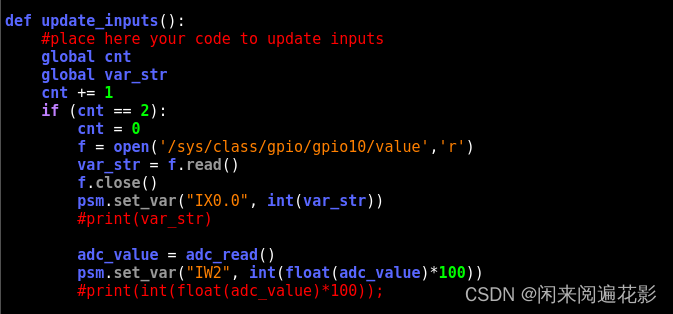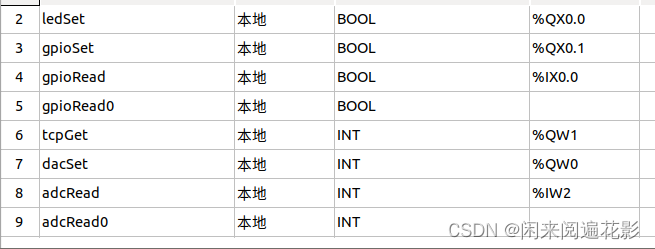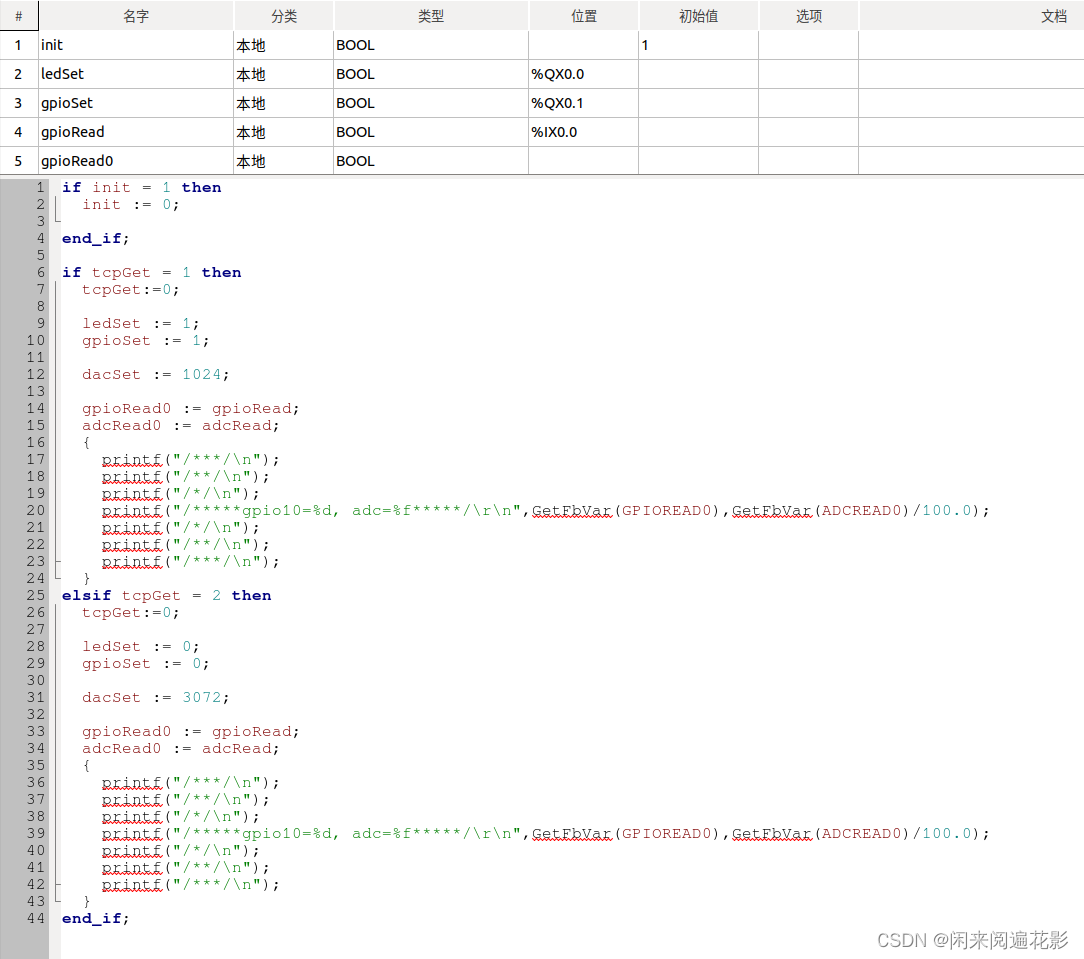1. 上一篇记录 openplc使用C语言文件读写驱动实现基本流程。
openPLC_Editor C语言编程 在mp157 arm板上调用io等使用记录_openplc c 编程-CSDN博客
2. 下面通过映射地址的方式控制io和读写驱动数据。
在runtime 环境的 hardware 硬件配置中 选择 python on Linux(PSM),这个可以通过python编程把openplc的地址和硬件控制结合起来。上层读写地址就能控制io。比如 QX0.0 写寄存器0或1 控制led灯开关。

3. python编程 地址映射
3.1 import psm ,导入psm库,可以读写内部地址。
qx00 = psm.get_var("QX0.0") 读取QX0.0的寄存器值,在openplc_editor中定义变量设置QX0.0 = 1,就可以qx00 = psm.get_var("QX0.0")读的值就是1。
psm.set_var("IX0.0", 1)给 IX0.0的寄存器赋值1,在openplc_editor中定义IX0.0的变量就可以读取。
3.2 在编辑框内默认代码有两个函数,update_inputs() 和 update_outputs()。
update_outputs() : 读取上层代码的输出变量,%QX0.0, %QW0之类的变量。比如

qx00 = psm.get_var("QX0.0") 判断QX0.0的值,=1 开灯, =0 关灯。
qx01 = psm.get_var("QX0.1")判断QX0.1的值,=1 gpio0置1,=0 gpio0置0。
qw00 = psm.get_var("QW0")读QW0的值,16位INT,设置DAC的输出值。
update_inputs() :设置上层代码的输入变量,%IX0.0,%IW0之类的变量。比如

psm.set_var("IX0.0", int(var_str)) 先读取gpio10的电平值,然后赋值给 %IX0.0 寄存器,上层代码读 %IX0.0就能 得到 gpio10的电平值。
psm.set_var("IW2", int(float(adc_value)*100)) 先读adc的采样值,float类型,*100变成int 赋值给 %IW2。上层代码就可以读 %IW2 得到adc的采样值。
4. python编程 驱动读写
还是跟C语言编程一样使用文件操作来读写驱动。如下 读写adc的驱动文件,获取采样值,换算成电压值。

5.完整代码,最好在notpad++之类的编辑器编好在复制过去。
#import all your libraries here
import psm
import time
import os#global variables
cnt = 0
var_str = ""
def hardware_init():#Insert your hardware initialization code in herepsm.start()f_led = open('/sys/class/leds/user-led/trigger','w')f_led.write("none")f_led.close()f_dac = open('/sys/bus/iio/devices/iio:device1/out_voltage1_powerdown','w')f_dac.write("0")f_dac.close()if not os.path.exists('/sys/class/gpio/gpio0'):f_io0 = open('/sys/class/gpio/export','w')f_io0.write("0")f_io0.close()f_in0 = open('/sys/class/gpio/gpio0/direction','w')f_in0.write("out")f_in0.close()if not os.path.exists('/sys/class/gpio/gpio10'):f_io10 = open('/sys/class/gpio/export','w')f_io10.write("10")f_io10.close()f_in10 = open('/sys/class/gpio/gpio10/direction','w')f_in10.write("in")f_in10.close()def adc_read():f_raw = open('/sys/bus/iio/devices/iio:device0/in_voltage19_raw','r')f_raw.seek(0,0)str_raw = f_raw.read()f_raw.close()f_scale = open('/sys/bus/iio/devices/iio:device0/in_voltage_scale','r')f_scale.seek(0,0)str_scale = f_scale.read()f_scale.close()return float(str_raw)*float(str_scale)/1000.0def dac_set( set ):if set >=0 and set <=4095:f_dac = open('/sys/bus/iio/devices/iio:device1/out_voltage1_raw','w')f_dac.write(str(set))f_dac.close()def update_inputs():#place here your code to update inputsglobal cntglobal var_strcnt += 1if (cnt == 2):cnt = 0f = open('/sys/class/gpio/gpio10/value','r')var_str = f.read()f.close()psm.set_var("IX0.0", int(var_str))#print(var_str)adc_value = adc_read()psm.set_var("IW2", int(float(adc_value)*100))#print(int(float(adc_value)*100));def update_outputs():#place here your code to work on outputsqx00 = psm.get_var("QX0.0")if qx00 == True:os.system("echo 1 > /sys/class/leds/user-led/brightness")elif qx00 == False:os.system("echo 0 > /sys/class/leds/user-led/brightness")qx01 = psm.get_var("QX0.1")if qx01 == True:os.system("echo 1 > /sys/class/gpio/gpio0/value")elif qx01 == False:os.system("echo 0 > /sys/class/gpio/gpio0/value")qw00 = psm.get_var("QW0")if qw00 >=0 and qw00 <=4095:dac_set(qw00)if __name__ == "__main__":hardware_init()while (not psm.should_quit()):update_inputs()update_outputs()time.sleep(0.1) #You can adjust the psm cycle time herepsm.stop()5.在openplc_editer 上层代码 变量定义

6.代码读写测试

tcpGet 是 modbus %QW1 写地址,通过网络调试助手连接502端口就可以发送。
发送 “00 00 00 00 00 06 01 06 00 01 00 01” 设置 tcpGet 变量 = 1,
发送 “00 00 00 00 00 06 01 06 00 01 00 02” 设置 tcpGet 变量 = 2,
如果 tcpGet == 1,
ledSet :=1 点灯,
gpioSet :=1 设置gpio0置1,
dacSet :=1024 设置dac的值=1024,0.8V
gpioRead0 := gpioRead 读取gpio10的电平值。
adcRead0 := adcRead 读取adc的值
打印值。
发送 “00 00 00 00 00 06 01 06 00 01 00 01”,gpio10 =1,adc=0.82v

发送 “00 00 00 00 00 06 01 06 00 01 00 02” ,gpio10 =0,adc=2.47v





))
——归并排序)





-2-CSS 盒子模型)







